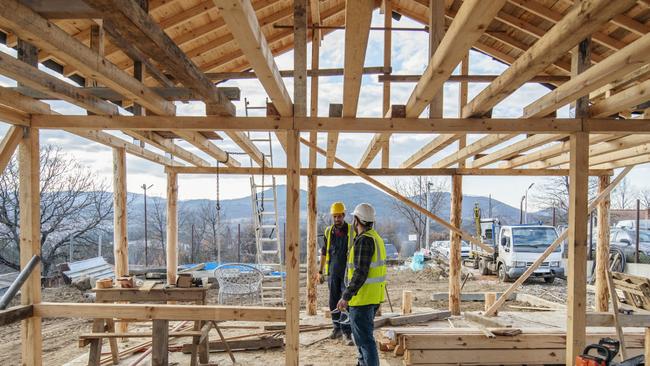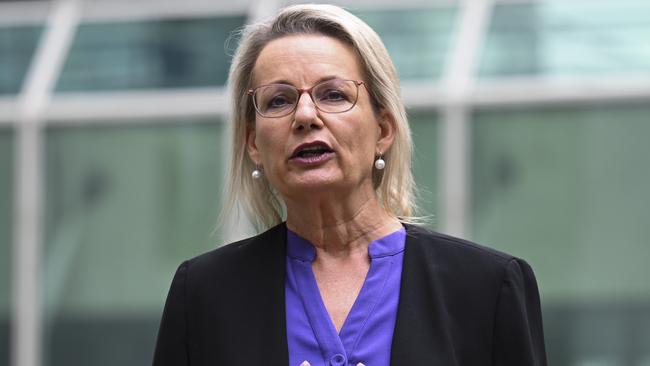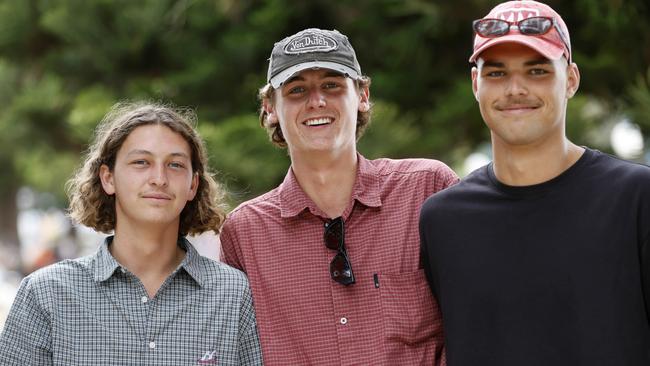Building industry says decline in Aussie apprentices in training a ‘concern’ amid housing crisis
Australia has 27,000 fewer apprentices and trainees than a year ago despite Labor’s promise to “rebuild” the nation’s skills pipeline.

National
Don't miss out on the headlines from National. Followed categories will be added to My News.
Australia has 27,000 fewer apprentices and trainees than a year ago despite Labor’s promise to “rebuild” the nation’s skills pipeline, as the construction sector calls on the Albanese Government to find ways to get more people in trades “beyond” pouring $1.5 billion into fee-free TAFE.
There were only 239,385 people in apprenticeships for a “trade” occupation like construction, electrical and automotive as of June 1 last year, a drop of about 2,000 compared to 2023, while “non-trade” roles like labourers, machinery operators and drivers dropped by about 25,000 to only 109,220 active trainees, new data from the National Centre for Vocational Education and Research shows.

The construction sector has warned Australia has no hope of addressing the housing crisis and reaching the goal of building 1.2 million new homes by 2029 without a significant increase in apprenticeships and traineeships.
A significant 13.3 per cent decline in female apprentices and trainees “in-training” is fuelling the dire trend, while every single state and territory is going backwards.
In NSW the number of apprentices and trainees in training dropped 8.4 per cent, Victoria declined 8.1 per cent, South Australia fell 9.1 per cent, Queensland down 4.7 per cent, the Northern Territory went back by 4.8 per cent Tasmania had a whopping 10.2 per cent drop.
About 86,635 Australians commenced a trade occupation over the 12 months to June 1, up slightly from 83,150 in 2023, but there were fewer new starters in “construction trades workers” specifically.

Deputy opposition leader Sussan Ley said collapsing apprentice and trainee numbers under Labor were a disaster for the economy, insisting the government could “no longer hide behind their flimsy excuses” the decline in commencements and people in-training was due to the end of the Coalition’s Covid-era skills incentives inflating the figures.
“With skills shortages, we should be seeing big increases in (apprentices and trainees) not drops,” she said.
Ms Ley said Labor’s skills policies were “failing” and fee TAFE had not increased the overall number of people in the nation’s trade training pipeline.
Master Builders Australia deputy chief executive Shaun Schmitke said the government must look “beyond” fee-free TAFE and consider all options to encourage new apprentices.
“We need to look at collaboration with training organisations that can work with apprentices and tradies, changing attitudes around taking up a trade by getting more information to school career’s advisers, and encouraging more women into the workforce to get the best conditions and outcomes for everyone in the industry,” he said.

Mr Schmitke said the “consistent decline” in new apprenticeships needed to be “a top priority for the government and should be of concern to all Australians”.
“New start numbers are in decline at a time when we are unable to meet minimum replacement rates within the industry or the need to increase the number of trades workers.”
A spokesman for the Department of Employment and Workplace Relations said there were strong commencement numbers in the latest data, which reflected the “importance of apprenticeship pathways to provide the workforce skills we need now and into the future”.
“As part of the 2024–25 Budget, the government committed an additional $265.1 million over four years to rebalance support to apprentices and employers working in priority occupations,” he said.
“By focusing investment towards priority occupations the government is working to ensure those industries in the greatest demand are receiving the most support.”
He said the government’s Building Women’s Careers Program was working to improve access to skilled and well-paid work in trades.

Northern Beaches tradies Solomon Ryan 18, Toby Mayhew 18, and Eli Denoon 18, all live at home and said the funding allocated to skills training should be put into increasing the minimum wage as no independent living apprentice could afford to make ends-meet on the entry-level rate.
“You can’t make a living if you’re apprentice … there’s no chance you have the money for the cost of living, Mr Ryan said.
“If you’re below 21, you’re getting normal apprentice wages which can be for first year $650 to $700, and it’s not buying you anything, but we are lucky because we’ve got our parents.”
The apprentice carpenter said the level of pays should be changed to help compete with other industries to boost numbers.
“If you’re a mature age apprentice, you are getting better money, which is about six more dollars per hour, so I feel like the age should be lowered once to once you leave school.”
The men said the money being put into TAFE isn’t helping with the curriculum, describing it as “outdated.”
“It needs to be looked at as a lot of the things in TAFE that we don’t use because it is outdate as we’ve got power tools now … so I don’t know where the money is going,” Mr Ryan said.
“A lot of parents look at it as an escape route, instead of a job opportunity,” said Mr Mayhew.
More Coverage
Originally published as Building industry says decline in Aussie apprentices in training a ‘concern’ amid housing crisis




